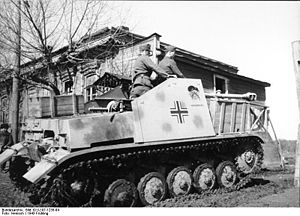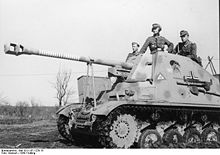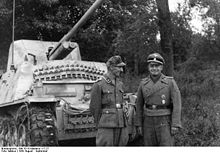- Marder II
-
Marder II 
This Marder II (Sd. Kfz. 131) was nicknamed "Kohlenklau" (Coal thief), after a propaganda caricature which was very popular in Germany from 1942 onward.Type Tank destroyer Place of origin  Nazi Germany
Nazi GermanySpecifications Weight 10.8 tonnes (23,809 lb) Length 6.36 m (20 ft 10 in) Width 2.28 m (7 ft 6 in) Height 2.2 m (7 ft 3 in) Crew 3 Armor 5-35 mm (.19 -1.37 in) Main
armament1x 7.5 cm Pak 40
37 roundsEngine Maybach HL 62 TRM
140 PS (138 hp, 103 kW)Power/weight 12.96 PS/tonne Suspension Leaf spring Operational
range190 km (118 mi) Speed 40 km/h (25 mph) The Marder II was a German tank destroyer of World War II based on the Panzer II chassis.
Contents
History
During the very first days of Operation Barbarossa, the invasion of the Soviet Union, the Germans were shocked to encounter Soviet T-34 medium tanks and KV heavy tanks. Although the Wehrmacht succeeded in most operations due to superior tactics, morale, and supply, it had few anti-tank weapons capable of successfully engaging these vehicles at normal ranges. An urgent need arose for a more mobile and powerful anti-tank weapon than the existing towed anti-tank guns or tank destroyers like the Panzerjäger I.
Among a series of solutions, it was decided to use light tanks like the Panzer II and captured vehicles like the Lorraine Schlepper as the basis for makeshift tank destroyers. The result was the Marder series, which were armed with either the new 7.5 cm Pak 40 anti-tank guns or captured Soviet 7.62 cm F-22 Model 1936 field guns, large numbers of which had been acquired early in the war.
Production
The Marder II came in two major versions. The first version Marder II (Sd.Kfz. 132) was based on the light Panzer II Ausf. D/E and Flammpanzer II chassis with Christie suspension. It was armed with captured Soviet 7.62 cm guns, re-chambered to accept German 7.5 cm Pak 40 ammunition, which improved its penetrative capabilities. These early Marder IIs had a very high silhouette (2.60 m high), thin armor of only 30 mm (front) and 10 to 15 mm (sides). There was no armour on the top or rear, leaving the crew with very little protection. Alkett and Wegmann produced 201 Marder II (Sd. Kfz. 132) from early 1942 to early 1943.
The second version Marder II (Sd.Kfz. 131) was based on Panzer II Ausf. A to C removed from active service but later also newly produced Ausf. F chassis were used. This Marder II had a redesigned (widened) fighting compartment and used the German 75 mm Pak 40 anti-tank gun. The silhouette was lowered by about 40 cm to 2.20 m, but the armor was thin and the compartment was open to the top and rear, as in Sd. Kfz. 132. FAMO, MAN and Daimler-Benz produced 576 Marder II (Sd.Kfz. 131) conversions from June 1942 to Mid 1943. 75 more were converted (probably by FAMO only) from mid 1943 to early 1944 when the last Panzer IIs were taken out of active service.
Combat history
 The famous[1] Marder II "coal thief" -recognizable by the cartoon painted on both sides- on the Eastern Front in 1943. The ring markings on the barrel indicate 19 claimed kills for the vehicle.
The famous[1] Marder II "coal thief" -recognizable by the cartoon painted on both sides- on the Eastern Front in 1943. The ring markings on the barrel indicate 19 claimed kills for the vehicle.
The various Marder IIs fought on all fronts of the war, mainly at the Eastern Front.
The Marder IIs were used by the Panzerjäger Abteilungen of the Panzer divisions of both the Wehrmacht and the Waffen SS, as well as several Luftwaffe units.
The Marder's weaknesses were mainly related to survivability. The combination of a high silhouette and open-top fighting compartment made them vulnerable to indirect artillery fire, shrapnel, and grenades. The armor was also quite thin, making them vulnerable to enemy tanks or infantry.
The Marders were not assault vehicles or tank substitutes; the open top meant that operations in urban areas or other close-combat situations were very risky. They were best employed in defensive or overwatch roles. Despite their weaknesses they were much more effective than the towed antitank guns they replaced.
References
- ^ Bryan Perrett; Mike Badrocke (1999). Sturmartillerie & Panzerjager 1939-45. Osprey Publishing. ISBN 9781841760049. http://books.google.com/books?id=HX1YLQZYcjYC.
External links
Tanks Panzer I · Panzer II · Panzer III · Panzer IV · Panther · Tiger I · Tiger II · Panzer 35(t) · Panzer 38(t)Self-propelled artillery Assault guns Tank destroyers Panzerjäger I · Marder I , II , III · RSO/PaK 40 · Nashorn · Elefant · Jagdpanzer IV · Hetzer · Jagdpanther · JagdtigerHalf-tracks Armored cars Self-propelled anti-aircraft guns Prototypes Panzer VIII Maus · E- series · Panther II · Heuschrecke 10 · Neubaufahrzeug · Sturer Emil · 10.5 cm K (gp.Sfl.) · Pz.Sfl. II · Flakpanzer Coelian · KugelpanzerProposed designs Categories:- World War II tank destroyers of Germany
Wikimedia Foundation. 2010.


